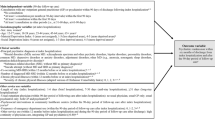Abstract
233 high-service-utilizing (HSU) psychiatric patients were recruited during an inpatient psychiatric treatment. They completed a questionnaire related to their treatment beliefs and were tracked via computerized medical records over 2 years. During the follow-up period, 79.8% were readmitted for additional inpatient psychiatric treatment. Survival analysis techniques were used to examine patients’ rates of readmittance during the follow-up period. Number of previous year inpatient psychiatric days served as a significant predictor of readmittance status and time to readmission. The survival plot was split by previous-year inpatient days to examine the effect of this variable on readmission. Implications of findings are discussed.

Similar content being viewed by others
References
Kent S, Yellowlees P: Psychiatric and social reasons for frequent rehospitalization. Hospital and Community Psychiatry 45:347–350, 1994
Walker R, Minor-Schork D, Bloch R, et al.: High risk factors for rehospitalization within six months. Psychiatric Quarterly 67:235–243, 1996
Havassy BE, Hopkin JT: Factors predicting utilization of acute psychiatric inpatient services by frequently hospitalized patients. Hospital and Community Psychiatry 40:820–823, 1989
Lewis T, Joyce PR: The new revolving-door patients: Results from a national cohort of first admissions. Acta Psychiatrica Scandinavica 82:130–135, 1990
Vogel S, Hugelet P: Factors associated with multiple admissions to a public psychiatric hospital. Acta Psychiatrica Scandinavica 95:244–253, 1997
Postrado LT, Lehman AF: Quality of life and clinical predictors of rehospitalization of persons with severe mental illness. Psychiatric Services 46:1161–1165, 1995
Song L, Biegel DE, Johnsen JA: Predictors of psychiatric hospitalization for persons with severe and persistent mental illness. Psychiatric Rehabilitation Journal 22:155–166, 1998
Moran PW, Doerfler LA, Scherz J, et al.: Rehospitalization of psychiatric patients in a managed care environment. Mental Health Services Research 2:191–198, 2000
Webb S, Yaguez L, Landgon PE: Factors associated with multiple re-admissions to a psychiatric hospital. Journal of Mental Health 16:647–661, 2007
Bridge JA, Barbe RP: Reducing hospital readmission in depression and schizophrenia: Current evidence. Current Opinion in Psychiatry 17:515–511, 2004
Priebe S, Broker M: Prediction of hospitalizations by schizophrenia patients assessment of treatment: An expanded study. Journal of Psychiatric Research 33:113–119, 1999
Ajzen I: From intentions to actions: A theory of planned behavior. In: Kulh J, Beckman J (Eds) Action Control: From Cognition to Behavior. Berlin, Springer-Verlag, 1985
Cochran SD, Gitlin MJ: Attitudinal correlates of lithium compliance in bipolar affective disorders. Journal of Nervous and Mental Disease 176:457–464, 1988
Voorhees BWV, Fogel J, Houston TK, et al.: Beliefs and attitudes associated with the intention to not accept the diagnosis of depression among young adults. Annals of Family Medicine 3:38–45, 2005
Ortega AN, Alegria M: Self reliance, mental health need, and the use of mental healthcare among island Puerto Ricans. Mental Health Services Research 4:131–140, 2002
Olfson M, Mechanic D, Hansell S, et al.: Predicting medication noncompliance after hospital discharge among patients with schizophrenia. Psychiatric Services 51:216–222, 2000
Warman DM, Lysaker PH, Martin JM: Cognitive insight and psychotic disorder: The impact of active delusions. Schizophrenia Research 90:325–333, 2007
Lingham R, Scott J: Treatment non-adherence in affective disorders. Acta Psychiatrica Scandinavica 105:164–172, 2002
Keck P, McElroy B, Strakowski S: Factors associated with pharmacologic non-compliance in patients with mania. Journal of Clinical Psychology 57:292–297, 1998
Weiden PJ, Olfson M: Cost of relapse in schizophrenia. Schizophrenia Bulletin 21:419–429, 1995
Ajzen I: The Theory of Planned Behavior. Retrieved October 5, 2005 from http://www.people.umass.edu/aizen.
Vaux A, Burda P, Stwart D: Orientation toward utilization of support resources. Journal of Community Psychology 11:159–170, 1986
Tata SP, Leong FTL: Individualism-collectivism, social-networkorientation, and acculturation as predictors of attitudes toward seeking professional psychological help among Chinese Americans. Journal of Counseling Psychology 41:280–287, 1994
Cecil H, Stanley MA, Carrion, PG et al.: Psychometric properties of the MSPSS and NOS in psychiatric outpatients. Journal of Clinical Psychology 51:593, 1995
American Psychiatric Association: Diagnostic and Statistical Manual of Mental Disorders, 4th edn, text revision. Washington, DC, American Psychiatric Association, 2000
United Stated Department of Health and Human Services: THE 2007 HHS POVERTY GUIDELINES. Retrieved June 20, 2009 from http://aspe.hhs.gov/POVERTY/07poverty.shtml.
Patterson, DA, Lee M: Intensive case management: A survival analysis. Research on Social Work Practice 8:152–171, 1998
DePaulo JR: Bipolar disorder treatment: An evidence-based reality check. American Journal of Psychiatry 163:175–176, 2006
Lehman AF, Steinwachs DM: Evidence-based psychosocial treatment practices in schizophrenia: Lessons from the Patient Outcomes Research Team (PORT) project. Journal of the American Academy of Psychoanalysis and Dynamic Psychiatry 31:141–154, 2003
Paul H: Issues and controversies surrounding recent texts on empirically based psychotherapy: A meta-review. Brief Treatment and Crisis Intervention 4:389–399, 2004
Pompili M, Amador XF, Girardi P et al.: Suicide risk in schizophrenia: Learning from the past to change the future. Annals of General Psychiatry 6:10, 2007
Haywood TW, Kravits HM, Grossman LS et al.: Predicting the “revolving door” phenomenon among patients with schizophrenic, schizoaffective, and affective disorders. American Journal of Psychiatry 152:856–861, 1995
Author information
Authors and Affiliations
Corresponding author
Rights and permissions
About this article
Cite this article
Bowersox, N.W., Saunders, S.M. & Berger, B.D. Predictors of Rehospitalization in High-Utilizing Patients in the VA Psychiatric Medical System. Psychiatr Q 83, 53–64 (2012). https://doi.org/10.1007/s11126-011-9182-2
Published:
Issue Date:
DOI: https://doi.org/10.1007/s11126-011-9182-2



